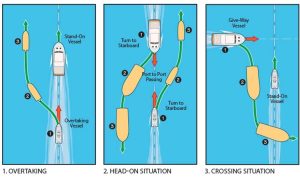Navigating busy sea routes presents a constant challenge for maritime professionals. Ship collisions, often resulting from human error, congested waterways, or inadequate navigational practices, pose severe risks to life, property, and the environment. Effective procedures for overtaking and collision avoidance are essential for ensuring maritime safety. This article outlines key navigational rules, risk assessment techniques, and collision-prevention strategies for safer voyages. Ship collisions can lead to catastrophic environmental damage, economic loss, and legal liabilities. The International Maritime Organization (IMO) mandates that seafarers follow the International Regulations for Preventing Collisions at Sea (COLREGs) to minimize collision risks. Understanding these rules is crucial for safe navigation and incident prevention.
Key Navigational Rules from COLREGs
The COLREGs provide a comprehensive framework for navigation, specifying how vessels should interact in different maritime scenarios.
Rule 13: Overtaking
- Definition: A vessel is overtaking if approaching another vessel from a direction more than 22.5 degrees abaft the beam (behind the side).
- Responsibility: The overtaking vessel must keep clear of the vessel being overtaken until it is well past and clear.
- Action: Maintain a safe passing distance, adjust speed, and communicate intentions clearly using sound signals or radio communication.
Rule 14: Head-On Situation
- Definition: A head-on situation occurs when two power-driven vessels approach each other on reciprocal courses.
- Action: Both vessels should alter course to starboard (right) to pass safely on each other’s port (left) side.
Rule 15: Crossing Situation
- Definition: When two power-driven vessels are crossing paths, creating a risk of collision.
- Responsibility: The vessel that has the other on its starboard side must give way, while the other vessel must maintain its course and speed.
Rule 16: Action by the Give-Way Vessel
- Responsibility: The give-way vessel must take early and substantial action to avoid a collision.
Rule 17: Action by the Stand-On Vessel
- Responsibility: The stand-on vessel must maintain its course and speed but be prepared to maneuver if the give-way vessel fails to take appropriate action.
–
Navigational Risk Assessment Techniques
Effective collision avoidance relies on continuous risk assessment and situational awareness. Seafarers must regularly evaluate navigation conditions and adapt strategies accordingly.
1. Use of Radar and AIS (Automatic Identification System)
- Monitor ship positions, speeds, and headings.
- Identify potential collision courses early.
- Ensure radar settings are optimized for range and sensitivity.
2. Visual Lookout and Watchkeeping
- Maintain a vigilant visual lookout, especially during restricted visibility.
- Use binoculars and lookout stations for early detection.
3. Risk of Collision Calculations
- Use the Constant Bearing Decreasing Range (CBDR) method: If a target’s bearing remains constant while its range decreases, a collision is likely.
4. Bridge Resource Management (BRM)
- Ensure effective team communication.
- Conduct pre-voyage risk assessments.
- Use checklists and decision-making protocols.
–
Collision-Prevention Strategies
Seafarers can apply practical strategies to prevent collisions by combining navigational best practices with technology-driven solutions.
Early and Decisive Action: Taking early action is essential to avoid last-minute maneuvers that could result in dangerous situations. Communicating intentions clearly using standardized sound signals or VHF radio ensures that surrounding vessels are aware of planned movements, reducing the likelihood of misunderstandings.
Speed and Course Adjustments: Reducing speed when approaching congested areas, narrow channels, or ports enhances control and response time. Adjusting course proactively increases the closest point of approach (CPA) distance, minimizing collision risks by maintaining a safer separation from other vessels.
Maintaining Safe Distances: Adhering to the “three-mile rule” in open waters helps maintain adequate separation between vessels. In high-traffic zones or during adverse weather conditions, applying greater distances ensures additional safety margins and reaction time in case of unexpected maneuvers.
Use of Navigation Tools: Electronic Chart Display and Information System (ECDIS) ensures real-time navigational awareness by providing precise positional data and chart updates. Radar and Automatic Radar Plotting Aid (ARPA) systems automatically track targets, displaying potential collision risks and enabling timely avoidance measures.
Night and Restricted Visibility Navigation: Displaying correct navigation lights and sounding fog signals as required by maritime regulations ensures vessel visibility and communication with other ships. Reducing speed and intensifying visual lookouts improve situational awareness in low-visibility conditions, helping to prevent collisions.
–
Case Studies: Lessons from Past Collisions
Case Study 1: MV Tricolor Collision (2002)
In December 2002, the car carrier MV Tricolor collided with the container ship Kariba in the English Channel due to poor visibility and communication failures. The incident underscored the need for better radar monitoring and adherence to COLREGs.
Case Study 2: USS John S. McCain Incident (2017)
A collision between the destroyer USS John S. McCain and an oil tanker in the Singapore Strait was attributed to navigation system confusion and human error. This highlighted the importance of maintaining situational awareness and crew training.
Future Trends in Collision Avoidance Technology
Technological advancements continue to improve maritime navigation and collision avoidance systems.
- Autonomous Vessels: Development of fully autonomous ships capable of collision avoidance using AI-powered navigation.
- Enhanced Navigation Sensors: Lidar and infrared sensors for improved detection.
- AI-Powered Decision Support: Real-time decision-making support for collision prevention.
Preventing ship collisions is a shared responsibility requiring strict adherence to navigational rules, continuous risk assessment, and the effective use of technology. By following COLREGs, applying best practices, and embracing technological advancements, seafarers can navigate safely, reduce accident risks, and maintain operational efficiency in increasingly congested waterways.




